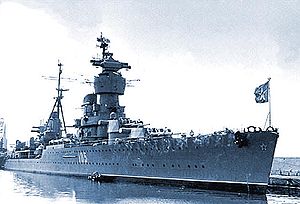- Chapayev class cruiser
-

Soviet cruiser KomsomoletsClass overview Builders: Baltic Yard, Leningrad
Nikolayev
Admiralty yard, LeningradOperators:  Soviet Navy
Soviet NavyPreceded by: Kirov class cruiser Succeeded by: Sverdlov class cruiser Planned: 7 Completed: 5 Cancelled: 2 Retired: 5 General characteristics Type: Cruiser, since 1949 — light cruiser Displacement: 11,300 long tons (11,500 t) standard, 15,000 long tons (15,000 t) full load Length: 201 m (659 ft) Beam: 19.7 m (65 ft) Draught: 6.4 m (21 ft) Propulsion: 2 shaft geared steam turbines, 6 boilers, 130,000 shp (97,000 kW) Speed: 35 kn (65 km/h; 40 mph) Range: 7,000 nmi (13,000 km; 8,100 mi) at 20 kn (37 km/h; 23 mph), 3,500 short tons (3,200 t) tons of oil fuel Complement: 840 Armament: 12×152 mm (6.0 in)/57 cal B-38 in 4 triple Mk5-bis turrets,
8×100 mm (3.9 in)/56 cal Model 1934 in 4 twin SM-5-1 mounts
28×37 mm (1.5 in) AA
6×533 mm (21.0 in) torpedo tubes (later removed)Armour: Belt: 50 mm (2.0 in)
Conning tower: 150 mm (5.9 in)
Deck: 50 mm
Turrets: 75 mm (3.0 in)Aircraft carried: 2 seaplanes planned (later removed) Aviation facilities: 1 catapult (later removed) The Chapayev class (Project 68 Чапаев) were a group of cruisers built for the Soviet Navy during and after World War II. Seventeen ships were planned but only seven were actually started before the German invasion. Three incomplete ships were destroyed when their building yard in Nikolaev was captured by Nazi Germany and the remaining five cruisers were completed only in 1950.
Contents
Design
The design was based on the Kirov class cruiser, but with significant changes in armament: 4 triple 152 mm (6.0 in) gun turrets replacing 3 triple 180 mm (7.1 in) gun turrets. The 152mm B38 guns fired a 55 kg (120 lb) shell to 24,000 m (26,000 yd). The rate of fire was 6 to 7 rounds per minute. The guns were mounted in individual cradles with separate elevation.
The secondary armament consisted of 100 mm (3.9 in) CM-5 guns in twin enclosed powered turrets with a rate of fire of 15-18 rounds per minute. The light AA guns consisted of 37 mm (1.5 in) weapons.
The hull was enlarged, and protection was improved compared to the Kirov class. The machinery was based on a unit system with alternating boiler rooms and engine rooms.
The five ships were completed after the war to a modified design (Project 69K). The aircraft facilities and torpedo tubes were removed and radar and improved anti-aircraft artillery added (37mm guns in twin powered and water cooled mountings).
Ships
A large programme was envisaged and seventeen ships were authorised in 1939 and eleven ordered. Six ships were to be built for the Baltic Fleet, four for the Black Sea Fleet and one for the Pacific Fleet. Seven ships were actually laid down before the German invasion in 1941.
- Chapayev (Чапаев)
- Named after Vasily Chapayev
- Built by Ordzhinikidze Yard Leningrad,
- Laid down 8 October 1939,
- Launched 28 April 1946,
- Completed 16 May 1950,
- Decommissioned 29 October 1960
- Zheleznyakov (Железняков)
- Named after Anatoly Zheleznyakov (1895-1919) a Bolshevik,
- Built by Marti Yard Leningrad,
- Laid down 31 October 1939,
- Launched 25 June 1941,
- Completed 19 April 1950,
- Decommissioned 1976
- Kuybyshev (Куйбышев)
- Named after Valerian Kuybyshev -
- Built by Marti Yard Nikolayev -
- Laid down 31 August 1939,
- Launched 31 January 1941, evacuated to Poti, Georgia (country); stern used to repair damaged cruiser Maxim Gorki,
- Completed 20 April 1950,
- Decommissioned 1965
- Chkalov (Чкалов) - later renamed Komsomolets -
- Originally named after Valery Chkalov -
- Built by Ordzhinikidze Yard Leningrad,
- Laid down 31 August 1939,
- Launched 25 October 1947,
- Completed 1 November 1950,
- Decommissioned 1981
- Frunze (Фрунзе) -
- Named after Mikhail Frunze -
- Built by Marti Yard Nikolayev -
- Laid down 29 August 1939,
- Launched 31 December 1940, evacuated to Poti, Georgia,
- Completed 15 December 1950,
- Decommissioned 1960
Two more ships, Ordzhinikidze and Sverdlov, were scrapped on the slipway after being captured by the Germans in Nikolayev during World War II.
See also
References
- Cruiser "Frunze" from Black Sea Fleet (in Russian, with photos)
- Cruiser "Kuybishev" from Black Sea Fleet (in Russian, with photos)
- Article in Russian language - http://ship.bsu.by/main.asp?id=102259
- MJ Whitley - Cruisers of World War 2, an International Encyclopedia, Arms & Armour Press 1995.
- Conway's All the World's Fighting Ships 1947-1995
- Conway's All the World's Fighting Ships 1922-1946
- (English) All Russian Chapayev Class Cruisers - Complete Ship List
Battleships Battlecruisers Cruisers - KominternS
- Svetlana
- MurmanskSUSN
- Tallin (Petropavlovsk)S
- Kirov
- Chapayev
Destroyers Guard ships Motor torpedo boats - Sh-4
- G-5
- D3
Submarines - S — Single ship of class
- RN — loan from Royal Navy
- USN — loan from United States Navy
Categories:- Cruiser classes
- Chapayev class cruisers
Wikimedia Foundation. 2010.
